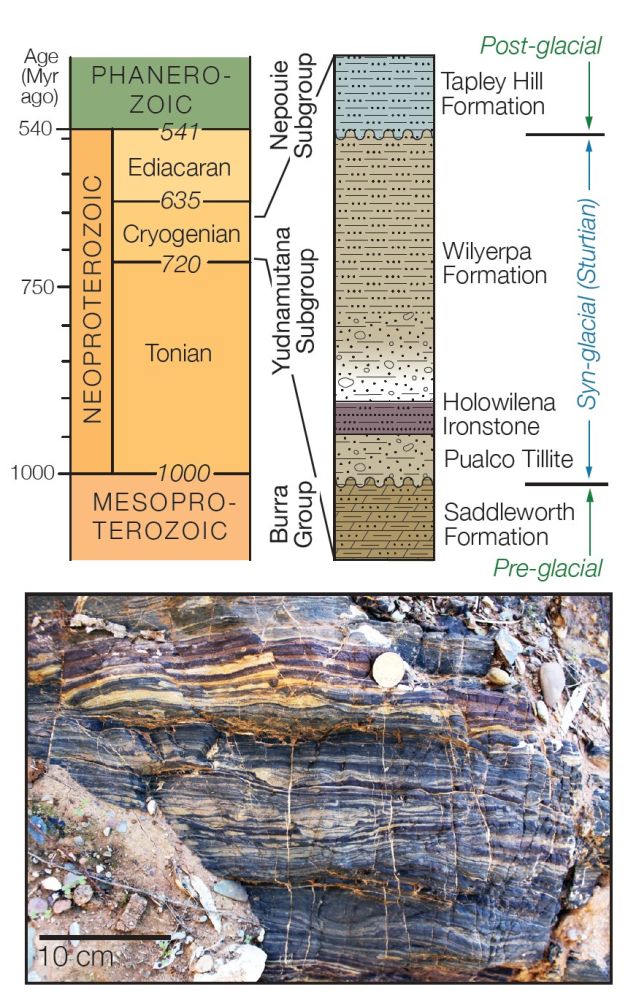加州理工学院的Joseph Kirschvink和哈佛大学的Paul Hoffman及其团队最初提出雪球地球假说时,他们描绘的极端气候事件引发了很大的争议。Gabrielle Walker撰写的一本引人入胜的书详细介绍了90年代末到2000年代初那些地质学家之间的精彩辩论。
在雪球地球获得广泛认可的今天,人们很容易忘记早期的分歧——但有的科学家从不遗忘。一项刚发表在Nature Communications上的新发现终于拔除了迄今为止还存在于雪球地球假说里的两根“肉中刺”。
“雪球地球假说面临的最大挑战之一就是,生命似乎幸存了下来。”本文作者之一,南安普顿大学的地质学家Thomas Gernon说。
“所以要么雪球地球从来没有发生,要么生命以某种方式逃过了极端冰川作用带来的灾难。”Gernon解释道。
另外一个雪球地球的挑战来自于岩石记录,在那个时期沉积的地层似乎有太多的相变。因为在雪球地球期间,冰封的海洋会完全和大气层断绝联系。没有了正常的海洋和空气之间的交流,许多在正常气候下会产生的沉积相变在雪球地球期间不应该出现。
“这被称作对雪球地球假说的‘沉积挑战’。” 中科院地质与地球物理研究所的Ross Mitchell研究员说,他也是本文的第一作者。
“这些岩层记录里的旋回看上去非常像是冰盖前进和后退时的气候旋回。”Mitchell解释道。雪球地球预测整个海洋都会被埋藏在冰下,而岩层记录里的变化性被认为与之相悖。
地质学家们决定检验沉积岩里旋回的真正成因。他们选定的目标岩石是位于南澳大利亚弗林德斯国家公园里的“条带状铁建造”。
条带状铁建造是一种含有薄层富铁沉积的独特沉积岩。在远古时期的地球上,条带状铁建造很常见,但自那以后它们基本上彻底消失,直到重现于约7亿年前的雪球地球时期。
“铁来自于海底的热液系统。”Gernon解释道。通常来说,大气层会快速氧化铁,所以条带状铁建造无法累积。但是在雪球地球时期,海洋与大气被隔断,铁能够富集从而形成条带状铁建造。
本文的地质学家们发现条带状铁建造的薄层沉积记录了冰川前进和后退的证据。 尤其是地层旋回的周期和地球轨道形状的变化(又称为米兰科维奇循环)呈关联性。
地球绕着太阳转动的轨道形状(也即离心率)呈周期性变化,地球自转轴的倾斜(倾斜度)和摇晃(岁差)也有类似的周期性变化。这些天文旋回改变着地球表面能接收到的太阳辐射的量,换句话说,它们控制着气候变化。
“虽然在雪球地球时期,地球的气候系统表现得完全不同,但地球幸福地对此一无所知,只是一如以往地进行着轨道变化。”Mitchell解释道。
并未参与本项研究,乔治梅森大学的Linda Hinnov教授说这项新发现称得上“非凡”,并表示很期待能够检验新研究提出的一项猜测,即全球性的冰川可能对地球的旋转有减速作用。
我们的祖先所经历过的冰期旋回在雪球地球期间也一样在运行着。
“这些持续不停的气候旋回导致的冰川前进和退缩在雪球地球时期和在今天别无二致。”Gernon说。
雪球地球时期的冰盖是动态的而非静态的这一发现解决了两个前文提到的长期存在的谜题。沉积旋回和生命的续存两者都得益于地球轨道不舍昼夜的变动。
研究成果发表于国际顶级专业期刊Nature Communications(Mitchell R N, Gernon T M, Cox G M, et al. Orbital forcing of ice sheets during snowball Earth[J]. Nature Communications, 2021, 12: 4187.)(原文链接)
A new way for life to survive Snowball Earth
Snowball Earth is the most extreme climate event Earth has ever seen. As opposed to ice sheets being restricted to continents only at high latitudes like Greenland and Antarctica today, the aptly named Snowball Earth would have engulfed the entire planet in thick ice.
When it was first proposed by Joseph Kirschvink of the California Institute of Technology and Paul Hoffman and his team at Harvard University, the extreme climatic event was an extremely contentious hypothesis. A page-turner written by Gabrielle Walker offers an inside look into the great debates among geologists in the late 1990s and early 2000s.
Now that the Snowball Earth hypothesis is generally accepted, it is easy to forget those early disagreements—but some scientists never forgot. A new discovery just published in Nature Communications finally reconciles what had remained, until now, two thorns in the side of the Snowball Earth hypothesis.
“One of the most fundamental challenges to Snowball was that life seems to have survived,” says Thomas Gernon, geologist at the University of Southampton and co-author of the study.
“So either Snowball didn’t happen, or life somehow avoided a bottleneck during the severe glaciation,” explains Gernon.
The other early challenge to the Snowball hypothesis came from the rocks themselves. There appeared to be too much variation in the layers of sediment deposited at that time.
During the Snowball, the frozen ocean would have been entirely cut off from the atmosphere. Without the normal exchange between the sea and air, many variations in climate that normally occur simply wouldn’t have.
“This was called the ‘sedimentary challenge’ to the Snowball hypothesis,” says Ross Mitchell, professor of the Institute of Geology and Geophysics Chinese Academy of Sciences in Beijing, China and the lead author.
“The highly variable rock layers appeared to show cycles that looked a lot like climate cycles associated with the advance and retreat of ice sheets,” explains Mitchell. Such variability was thought to be at odds with a static Snowball Earth entombing the whole ocean in ice.
The geologists decided to test the precise origin of the cycles in the sedimentary rocks. The rocks they targeted were “banded iron formation”, or BIF, in the Flinders Ranges National Park of South Australia.
BIF are unique sedimentary rocks with very thin layers of very iron-rich sediment. Although BIF had once been abundant on ancient Earth, they had essentially gone extinct until their reappearance during Snowball Earth about 700 million years ago.
“The iron comes from hydrothermal vents on the seafloor,” explains Gernon. Normally, the atmosphere oxidizes any iron immediately, so BIF typically doesn’t accumulate. But during the Snowball, with the ocean cut off from the air, iron was able to accumulate enough to form BIF.
The geologists discovered that the thin layers of BIF recorded evidence of the advance and retreat of ice sheets. In particular, the tempo of the cycles related to Earth’s orbital variations, known as Milankovitch cycles.
Earth’s orbit around the sun changes its shape, or eccentricity, and the tilt and wobble of Earth’s spin axis, known as obliquity and precession, also undergo cyclic changes. These astronomical cycles change the amount of incoming solar radiation that reaches Earth’s surface and, in doing so, they control climate.
“Even though Earth’s climate system behaved very differently during Snowball, Earth’s orbital variations would have been blissfully unaware and just continued to do their thing,” explains Mitchell.
Linda Hinnov, Professor at George Mason University who was not involved in the study, describes the discovery as “remarkable” and looks forward to testing one of the implications of the study that the global glaciation might have slowed Earth’s rate of rotation.
The ice age cycles that our ancestors endured would have also been operational during the Snowball.
“These ongoing orbital climate cycles caused the Snowball ice sheets to advance and retreat just like they do today,” says Gernon.
Now knowing that Snowball ice sheets were dynamic, not static, solves the two long-standing riddles. Both the sedimentary cycles and the survival of life were aided and abetted by Earth’s ongoing orbital variations.

(Top) Sedimentary rocks of South Australia including the Holowilena Ironstone studied here that is sandwiched between glacial deposits. (Bottom) Field photo of the Holowilena Ironstone showing fine sedimentary layering ideal for this study.
The article can be found online: https://www.nature.com/articles/s41467-021-24439-4
